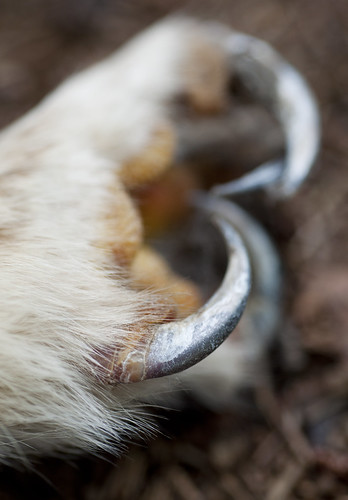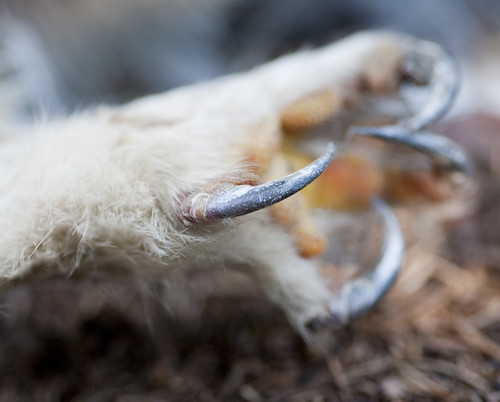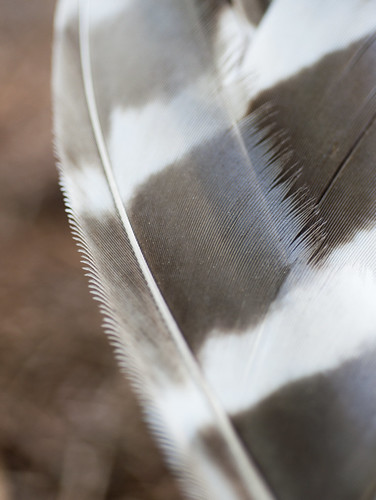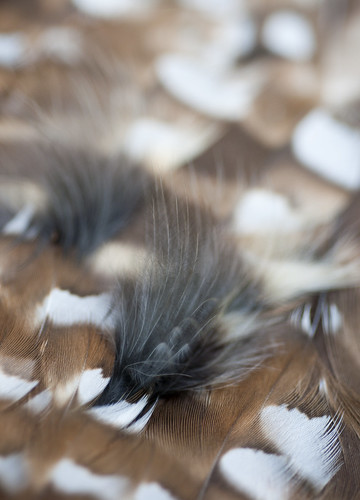Owl-car collisions are not rare. Oftentimes, owls will perch in trees alongside roadways at night, waiting for rodents and other small animals to appear. Nighttime traffic and swooping owls isn't an optimal situation, and the owls always lose out in the end. Other birds of prey suffer the same fate: hawks, eagles, and vultures are common victims, as well. The difference with owls is that they are active at night, and ghostlike, seem to materialize from thin air.
• • •
Steph called me while she was on her way to Munising, and said that about thirteen miles out, there was a large, brown-and-white bird, dead in the middle of the road. I hemmed and hawed for a while, not sure if it was worth driving the almost-thirty-mile round-trip for a mystery bird that could potentially be obliterated by the time I arrived. I finally gave in, however, and set off down M-28 – and I'm glad I did, because it presented me with the unique and sobering experience to see, touch, and photograph a roadkill barred owl.
In the time that it had taken me to get there, the owl's body had traveled another two miles. Just a wing, tail, and feet, held together by some battered bones, the carcass was stuck in the weeds alongside the road. At first glance, I thought that it was all damage from being run over by cars, again and again, but a closer look made it clear that the owl had actually been dead for some time. The bones were dry and gnawed upon, the connective tissue was hard, there was no blood to speak of. In the days prior, the owl had likely been hit on the road, and then subsequently been discovered by a scavenger. How many animals had fed on it, before the owl was deposited in the middle of the highway?
Since there wasn't much left of the body, I focused on documenting the barred owl's feet and feathers. Owls are highly specialized birds, with some unique features that aid them in their nighttime, predatory behavior.



Barred owl feet are special, and are quite different from those of other birds – and even some other owls. The toes are arranged in a way that allows them to grasp onto branches and prey with ease. The talons are long, curved, and sharp, and resemble fishhooks. The entire leg, as well as the top of the foot, is covered in dense, fur-like feathers, which is important for a bird that lives year-round in the northwoods. The underside of the foot, meanwhile, is lined with bumpy scales – also to aid with grip.
Owls are famous for being silent fliers. How do they do it? Their flight feathers have a modified, fringed edge, as seen in the first and third photos above. When drawn through the air, the feather – and the entire wing – is noiseless. It makes for a silent flier, and a successful hunter. Also important for the owl is its coloration. Owls have markings that help them blend into their surroundings; in the case of the barred owl, its plumage is dappled and brown, making detection in a forest quite the challenge.
I've never had the opportunity to see or hear a wild, living barred owl. In that respect, finding one dead on the side of the road is both frustrating and sad. However, having the chance to see it up close – the feathers, the talons – allowed me to learn a great deal more about this beautiful animal.










No comments:
Post a Comment